A step-by-step guide to planning a workshop

Going from a mere idea to a workshop that delivers results for your clients can feel like a daunting task. In this piece, we will shine a light on all the work behind the scenes and help you learn how to plan a workshop from start to finish.
On a good day, facilitation can feel like effortless magic, but that is mostly the result of backstage work, foresight, and a lot of careful planning.
Read on to learn a step-by-step approach to breaking the process of planning a workshop into small, manageable chunks.
The flow starts with the first meeting with a client to define the purposes of a workshop. In other words, we are working on the assumption that the facilitator has already been chosen and hired for a job.
It’s also possible that you are designing a workshop agenda you have ideated yourself. You have a topic to share with your audience, and potential participants in mind… great! You can still use the same process, although not all steps may be relevant to your case.
How to plan a workshop in four phases
We have divided the process of designing a workshop step-by-step into four sections. This structure is inspired by the insightful design methodology known as Dragon Dreaming, as codified by John Croft. The framework is an invitation to move in a structured way from dreaming to designing, from designing to doing, and from doing to celebrating and learning.
In this workflow, we will go through similar steps, albeit much simplified and adapted to this specific example. If you find this categorization intriguing and you’d like to learn more, here is a page about Dragon Dreaming project design. The methodology originated in Australia, and you can see a wink to its origin in how the design turns counterclockwise!

Each phase (vision, design, action and learning) is divided into subsections defining specific actions you need to take in planning your workshop. Each also includes a checkpoint with the client. These four meetings, plus a facilitation team meeting to draft the agenda, are described in detail in the accompanying Workshop Planning Template.
In the template, you will find ideas and inspiration for five one-hour meetings in which to:
- draw out the overall vision and desired outcomes;
- define a draft schedule;
- get buy-in for the workshop agenda;
- check-in for a briefing before the actual workshop;
- run a retrospective after the event is over.
I see this process as a dance between working alone and co-designing with a client. In this dance, two different ways of working interact, from being alone at the desk surrounded by sticky notes, to talking things over and getting feedback, into a new iteration of the design, and so on. Successful workshops all start, as most things do, with a vision, and a conversation. Let’s take the first step!
Phase 1 – Vision
Every project begins as an idea in somebody’s mind, which really starts to take shape once it’s shared with someone else. In the first part of the process, we cover how to lead conversations that will move the idea from the abstract to a more concrete realm.
This process starts with a kick-off meeting attended by the facilitator, the client and, if applicable, other members of the team. To help you set it up, we have prepared a dedicated template complete with a workshop structure you can use to collect all the information from this visioning stage!

What are the desired outcomes of the workshop? Who will be the participants or what is your target audience? Once you have some initial answers to these questions, you can use them to shape a concept note, sign agreements, contracts and/or an MoU (memorandum of understanding).
Sharing intentions
According to the State of Facilitation in 2023 report, a majority of facilitators find negotiating with clients and stakeholders quite the challenge. In the survey on which the report is based, we asked over 1100 professionals what was hard for them in the previous year.
While the top challenge reported was “keeping up with the trends”, a series of matters more related to difficulties negotiating, designing and getting buy-in from stakeholders emerged as well. We hope the following workshop planning tips can help you overcome such obstacles. Learn more about trends in facilitation in 2023 and the art of running workshops in the State of Facilitation report!
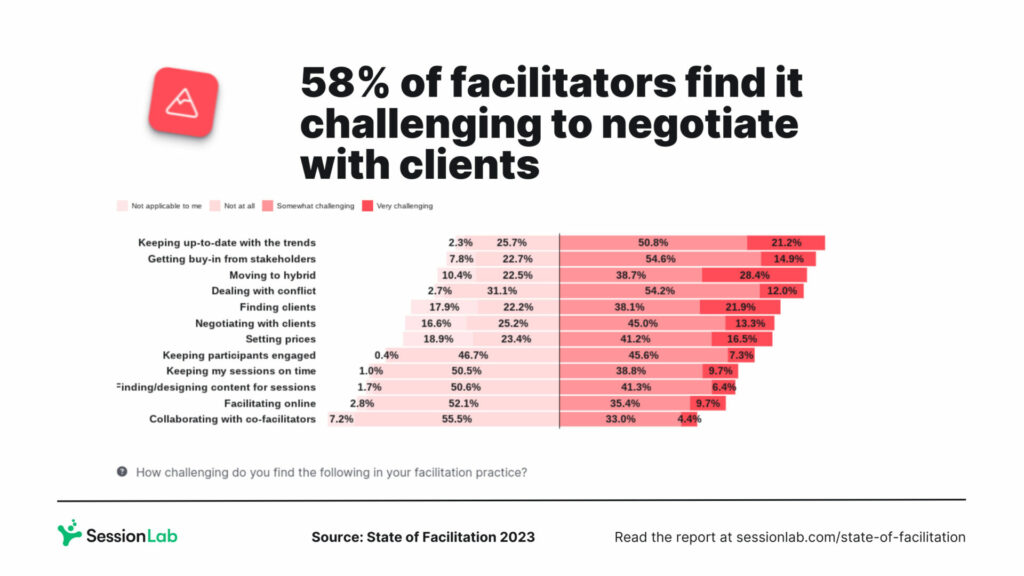
Designing based on the “why” is a necessary premise to design workshops that will prove meaningful to participants and clients. Often, though, this “why” is not entirely clear from the get-go. A skilled facilitator will use a range of communication skills such as probing questions, active listening, and appreciative inquiry to clarify intentions.
In most cases, it’s a matter of slowing the client down, and gently inquiring into their motivations. Run a mini-workshop with your client and transparently share what you are looking for. Time spent on this now will save time and resources by minimizing the risk of misunderstandings and re-writes later!
There are four key elements I check for when looking for desired outcomes with the client at this very early stage:
(1) Non-negotiables. These are the boundaries for your design, the things that are set and cannot be changed. This might be, for example, the duration of the workshop, the location, or the list of participants.
(2) Tangible outcomes (aka deliverables). What needs to be produced, concretely, by the end of the workshop? Is it an action plan? A set of decisions? A report? Try to get as many details as possible on this requirement.
If this point is not initially clear, invite your client to explore the future with their foresight and imagination: at the end of the workshop, what do they want to have that was not there before the start?
(3) Intangible outcomes. What intentions are connected to the workshop in the immaterial world of communications, connections and emotions? Mark down the keywords you hear your client use. Is it a matter of increasing networking opportunities and connections? Deepening trust? These “soft” outcomes can inspire and direct your choices of activities, setting and style.
(4) Levels of participation. If you are planning a workshop rather than a training event, I have found it very useful to introduce the concept of the ladder of participation to clients, early on in the design stage (here is a version relating to citizen engagement).
This involves probing how much power is allocated to participants into shaping future choices. Will proposals selected by participants in your workshop be adopted directly? Is this a consultation process someone else will turn into a decision later? Or, perhaps, the workshop is meant to inform and get buy-in on choices that have already been made?
All these scenarios are possible and valid, but it’s important to know which one your workshop falls into, so as to minimize the risk of disappointment or confusion.
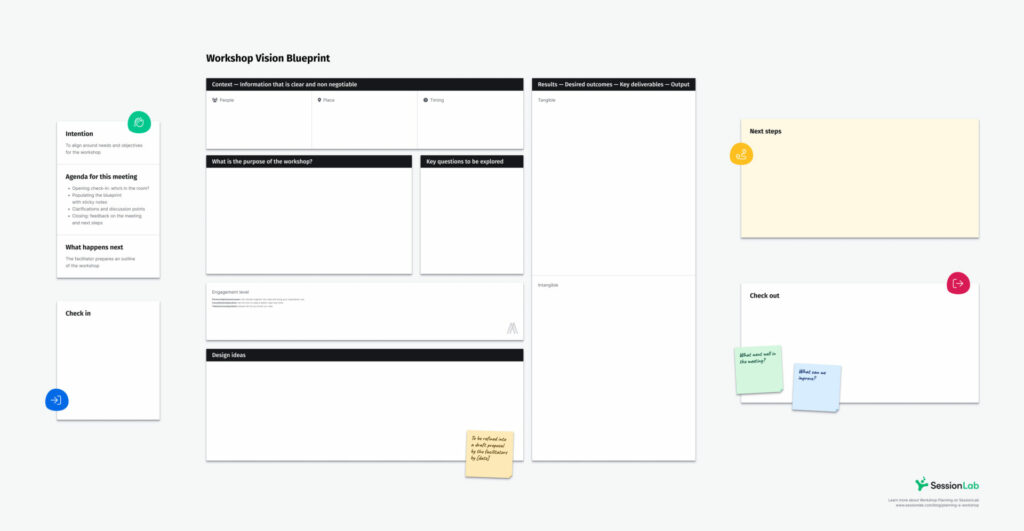
Once you have collected this information, you probably have an idea of where you want your workshop to focus. All you need now is to figure out who is it for before drafting a concept note and initial agenda.
Defining the target audience
Once you have clarity about the desired outcomes, it’s time to focus on your hypothetical participants and your target audience. You may already have a list provided by the client, or it may be a completely open invitation. In any case, it’s a good idea to spend some time focussing, after the “why”, on the important question: “who?”
Things that can be useful to consider doing at this stage, depending on the specific situation, include:
- Creating a “persona” for the workshop. Who will benefit? What are their needs, pain points, interests? Why will they come? This work will initially be based on your assumptions only, but it could lead to an exchange of information with your client to learn more. Here is a canvas from MediaLAB Amsterdam that can help you create a persona for your event.
- Having interviews with potential participants that match your target audience to collect more information on their wants, needs and expectations. If you are able to contact participants before the workshop, aim to talk to a few. If key decision-makers will be in the room, it’s definitely a good idea to ask for a half-hour chat with them!
Start by clarifying that you are talking to a few people in order to better prepare your workshop. Next, kick-start your exploration by asking them what their motivation for attending the workshop is. Listen carefully and take notes! It’s good practice to have a list of questions that will be the same for all your interviewees, but also let the conversation flow naturally.
End the conversation by asking your interviewee whether they know of someone who should definitely be at the workshop, and add them to the list of potential invites!If time does not allow for 1:1 interviews, you can also consider sending your questions out via email.
Finally, check back in with the client to ensure they have considered who should be there and whether any important stakeholders or potential workshop participants are being overlooked.
In my personal practice, I do hold a commitment to widening representation and will often reach out to my clients with questions, for example, on gender balance or including underrepresented groups. Can we get more women’s voices in a conversation about the future of logistics and mobility? (The answer turned out to be yes!). In this urban planning process, will someone be speaking with the interests of elderly citizens in mind? And what about the children’s?
At this stage, it’s also important to start making notes of any special needs. Does your persona include, for example, families with small children? Or people with mobility concerns? These considerations have a bearing on such key planning elements as your choice of venue, location, and timing. Successful workshops are those in which the needs of target attendees are considered and steps are taken to ensure participants can take part.
Drafting the initial concept
Once you know the “why” and something around the “who” of a workshop, it’s time to start designing the “what”.
What is needed at first is some clarity as to the main points of the agenda, not a detailed run-through. The client will probably have more feedback once things start to look concrete, and it’s not particularly fun to have to revisit the entire thing and do work twice. That is why I have found it good practice to keep the agenda still quite open at this stage.
An initial concept draft for a successful workshop should contain:
- A summary of the desired outcomes;
- A list of benefits for participants (what are their pain points that this workshop will solve?);
- A list of learning/key objectives;
- A description of the main activities or building blocks of the workshop.
At this point, you’ll need to circle back to your client, share the draft with them and ask for feedback. In my experience, it’s a good idea to approach this step lightly, with curiosity, knowing you have done your homework but ready if necessary to change your entire concept around and pivot to something different. And if you still feel yourself having rigidity towards feedback, check out some useful feedback tips by learning expert Skye Suttie.
Signing agreements
By the end of the vision phase, facilitators and clients should share a feeling of commitment and alignment. This is made visible and concrete through signing agreements, contracts and/or a memorandum of understanding (MoU).
What exactly these contain varies greatly depending on circumstances and location, but here is a useful summary, complete with template examples of what your MoU might look like, from Malia Josephine over at the startup Facilitation Jobs.
Phase 2 – Design
So now you have a draft outline of the workshop and an idea of who will participate. The next section is all about the nitty-gritty details of planning. Think of any other event, such as a family gathering or a wedding: there are a lot of things to consider so that everything will be ready when attendees arrive in the space you have designed and set up for them. It can be a very creative phase, if a bit solitary at times for the workshop leader!

Photo by Firmbee.com on Unsplash
In the design stage, we are aiming to answer the question: how will this happen? This includes choosing dates and venues, drafting an agenda, creating a communication plan so that your workshop attendees will get the invite and join, populating a participant list, and refining your draft agenda into a detailed script.
Establishing time and place
A workshop begins to feel like it’s really going to happen once the date and location are decided upon.
Whether you are scouting for a location yourself or not, you still need to clarify and communicate a list of requirements clearly. Don’t give anything for granted! List any needs such as accessibility, type of space, and equipment such as tables or presentation equipment. No location is going to be perfect, but the clearer your request, the closer to ideal you might get.
If you’re running a virtual workshop, you still need to put it in the calendar and arrange for a virtual space to hold it in, such as a Zoom account and a whiteboard space. And if it’s hybrid, you’ll need to do both: scout for a location (with great wifi and acoustics, here you can read more about why that’s important) and set up online resources as well. If you don’t know yet what kind of room setup you will need, take a look at our detailed guide here.
Once the location has been chosen and booked, make sure you have an understanding with the location manager of how your session will work and what they can expect.
Will you be using masking tape to hang posters on the wall? Is that ok? How early do you expect to be at the location, and who will be there to open the doors? Will you need breakout spaces for smaller groups to work in? Will participants be milling around using outside spaces, which, and when? What about wifi use, passwords, and other tech needs?

Photo by GeoJango Maps on Unsplash
Having a persona in mind might help establish a schedule. Is this a personal development workshop that people sign up for as individuals (that will probably mean running it in the evening or on weekends?) Or is it going on at the workplace? When are employees free to attend, and what will not clash with previous engagements? Will it be a one-off thing or a series? Successful workshops take all this into account to ensure workshop participants can actually be there!
If you are working on a series of meetings for participatory planning and would like to encourage a diverse attendance, it could be a good idea to switch times and dates around quite often, so that people with different jobs and schedules can fit at least one meeting in. And get a babysitting service, or have someone who works with youth set up a related workshop with the young ones.
Drafting the workshop agenda
So now the word is out, and there is probably some time to wait before the workshop kick-off. This is the moment to sit down with yourself and work on the facilitation design. For many trainers and facilitators, this is a favorite part of the process.
Here is where we create a detailed schedule, choose activities and methods and assemble them into a coherent flow. You’ll seek to create a workflow flow that balances group discussions, experiential activities and different learning styles in order to meet your workshop’s purpose. Proper planning and a structured process is a proven way of turning a workshop idea into a reality.
Using a workshop planning tool like SessionLab can make the task much easier and save you time in your process.
A successful workshop is one with a clear structure that supports the learning process. With the Session Planner, you can easily drag and drop your content blocks to quickly build an effective flow.
I like to start by creating a skeleton of each item in the workshop agenda and then adding additional content once I feel confident in the flow.

SessionLab also ensures you stay in control of time while creating your workshop agenda. Add timing to each block to confidently plan for the time you have available. And when you make changes, SessionLab will automatically calculate your timing. It’s easy to iterate and plan the most effective workshop flow for your participants.
Need inspiration? Research and exploration into the methods library can help you find suitable activities for your session, as well as other online repositories of ideas such as this one by Untools.
The actual process of creating a draft agenda is quite personal. You may be working on it completely alone (hopefully, with a hot or cold beverage of your choice, and plenty of time!) or with a co-facilitator.
Results from the State of Facilitation report indicate that facilitators like to work directly with online tools, such as SessionLab, others, me included, prefer to start with pen and paper… or by taking voice notes while taking a walk!

However you approach the matter, you are likely to do all of these things (and more!), while not necessarily in this order:
- Create a timeline, showing when your workshop starts, ends, and how long each section will last;
- Check your notes from meeting with the client, refer back to desired outcomes both tangible and intangible;
- Refer back to your interviews with participants, or any other information you may have collected from them, to pinpoint main needs and expectations;
- Brainstorm activities you believe will meet the client’s and the participants’ needs;
- Pick among those activities: which are “must-haves” and which are optional?
- Assess how much time each activity will take, and add a bit of buffer to account for the unexpected;
- Check that your activities are diverse enough to include people with different styles and approaches (e.g. by having both individual and group activities);
- Add essential opening and closing activities such as icebreakers and introductions at the beginning and feedback and drawing conclusions at the end
- Arrange them in a timeline;
And whatever you do, don’t forget to schedule some breaks! A successful workshop ensures that the workshop facilitator and all participants are able to participate and maintain their energy levels will learning new skills.
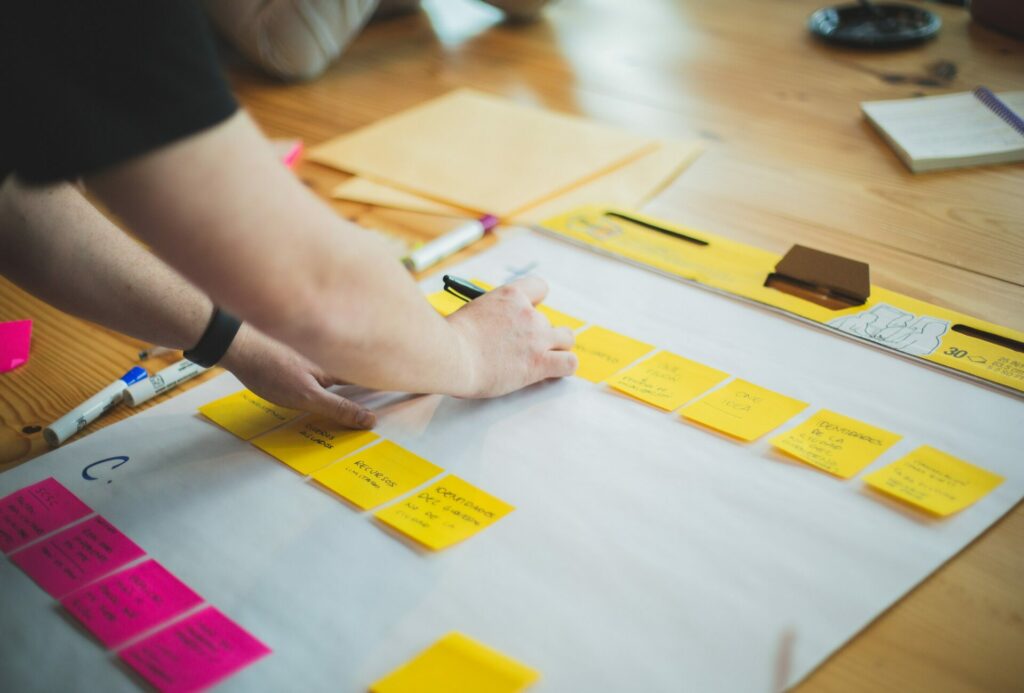
Refining the agenda
Once you have a solid agenda, it’s time once more to check in with the client. Run through the agenda together, checking that you share an understanding of what is going to happen, and making any needed tweaks and changes as you go. I always aim to share my reasoning with clients and share tidbits of facilitation along the way.
If you’re using SessionLab, you can invite clients and stakeholders directly to your agenda so you discuss and co-create in real-time or asynchronously. Collaborating in one-place can really help ensure your workshop preparation is smooth and that your session will meet your goals.
Refining the agenda is the subject of the third client/facilitator meeting detailed in the template that goes with this piece. The first thing to do is restate the high-level purpose and objectives of the workshop, before going into a review of details. This process encourages clarity and alignment, as well as enabling the facilitator to check whether the proposed agenda is fit for purpose.
This is also the stage in which, if I am facilitating a group discussions on a topic I am not familiar with, I’ll be doing research into that topic. Opinions about how knowledgeable, if at all, a facilitator should be about the topic under discussion vary greatly. Personally, my attention is on the dynamics of their conversation rather than on the content. Because of this, I don’t mind working with groups or companies who are talking about something I am not informed about.
At the same time, I find it useful to have at least a beginner’s understanding of the discussion. To enable this, I will ask clients to send me some papers or links to study. Mainly, I will be looking for jargon and terminology: I want to have at least a sense of what people are talking about and what terms to use myself. I also try and get a sense of what in the field is clear, and what is contested or up for debate.
Research can lead to changes to the agenda: in a recent workshop I chaired, reading some documentation led me to assume that terminology being used in the field was still not well-defined. Different stakeholders were using different terms to indicate the same things, or the same term to indicate different things!
I checked in with the client to verify if this was indeed the case and we decided to add a section discussing terminology at the beginning of the workshop. We did not aim to settle the argument once and for all, but rather to share with participants the current state of the art in this particular industry and agree on what terms we would use for the duration of the workshop.
This is also a great time to reconsider the implications of your setting. If you’re running a virtual workshop, how will you encourage participants to take part and explore ideas in such an environment?
Creating a communications plan
Whether you are opening the workshop for participants to enroll or whether it’s the host preparing a list of attendees, it’s likely someone will be working to create a buzz around the event.
Often this is not handled by the facilitator directly but rather by a communication agency or office. That said, do your part by preparing material for dissemination and helping make sure the news reaches the right ears.
If you are not doing communication and enrollment yourself, avoid missteps (such as the advertising sending a message that is not aligned with your intention and design) by preparing such a brief well in advance.
A basic communication plan for your workshop should include:
- How will people find out about the workshop? Where will it be advertised? Are there networks, groups or individuals that should be reached out to?
- What should people know about the workshop in advance? Create a one or two-sentence description of the workshop to go out in communication channels and invitations. What is the workshop’s unique value? How can you entice people to be excited to join?
- How will people enroll in the workshop? And how can they find out more? Who should they contact to register, is it you, or the client, or should you set up an automatic registration service (such as Eventbrite)? What information do you need to collect upon registration? Do participants need to sign authorizations (e.g. for audio-video use)? Will they get a confirmation email? Automatically or through you/the client?
Establishing who will be there
Many hands make light work: now that you have your detail agenda or script set out, you should have a clear sense of whether other people are needed to make it work. Will you need a tech host? An assistant to help with the practicalities? A video-maker? Photographer? Visual practitioner? If you need to assemble a team, it makes sense to onboard them once you know the agenda and tasks they will take on.
The other aspect of establishing who will be there is having a final (or “almost final”… there are usually last-minute surprises!) participant list. Registration can also be an interesting opportunity to collect information on your workshop attendees that might inspire some final details of the design.
When registering participants for a short (3-hour) leadership workshop for the international organization C40, besides asking for basic information such as names and emails, I added three optional questions concerning people’s motivation for joining, interesting initiatives they might like to share, and a blank space for “any other communications”.
This process was useful for me to start to get a sense of who was going to be in the room and adapt my choices and language to the audience. Furthermore, these questions can kick-start the workshop long before it begins by asking participants to start reflecting on a certain topic.
Phase 3 – Running the workshop!
As the moment of running a workshop draws closer, there are some tasks to do that are very practical, having to do with implementing what has, up to now, existed in words only.
This is the phase for getting things done: assembling materials, briefing your team and any speakers, taking care of your inner work and preparation and then, in a leap of faith…Trusting that all you’ve done is enough, finally doing away with plans, and going with the flow!
Running workshops can be tough work, so in this section we’ve collected some tips for managing workshop attendees (and yourself) that should help running the workshop easier!
Assembling materials
Shopping time! The stationery shop is like a second home to most facilitators: it’s time to get your gear together and fill up boxes of sticky notes, posters, and marker pens. Now things are getting real! (And if you used SessionLab to plan your session, you’ll find a handy list of materials consolidated on the information page!)
As the date of the workshop approaches, make sure you have all the materials you need ready at hand. This might include your presentations, virtual whiteboards, or physical goodies. I have found myself roaming Rome at dawn to get photocopies of materials in a neighborhood with no such services. Not fun!

Photo by Camille San Vicente on Unsplash
I often wonder how important is it to give participants printed handouts. On the one hand, let’s admit it, such materials don’t often get read. Printing is a waste of energy and paper and my sustainable-minded self would rather avoid it.
On the other hand, printed materials might be a useful reference a long time after the workshop is over, and many people like to have something physical to hold onto and take notes on. You can also consider the option of having digital-format handouts to send to everyone before or after the workshop.
Briefing team and speakers
A few days before the workshop, set a briefing call with the client, your team and, if applicable, speakers or other guests. I have sometimes avoided doing this for the sake of efficiency… and usually regretted it. Even though it seems like everything is clear and smooth, by talking a workshop through, even in a brief 30 min meeting, something might emerge that needs attention.
If you have external speakers joining, e.g. for a keynote or presentation, remember they have not dedicated the amount of time and attention to this event that you have! Brief them on the intention behind the workshop and on the participants in the room, and discuss what will happen before and after their speech. As your star guests, they should feel welcome and well prepared. This will improve alignment and the overall experience for participants.
When running a workshop with a team, it’s very important to know who will take care of what. Take the time to clearly define roles and responsibilities and add to the script the name of the people who will be, for example, presenting or tech hosting at a given time.
You might also have pre-workshop communication you want to send out to participants, perhaps to remind them of logistics or do some prep work. Always include a way to contact you (or someone from your team) if something happens at the last minute!
Personal energy management
Once all the design and preparation are done, so much rests on the facilitator’s personal stance and attention. Here are some examples of things facilitators I know, or myself, do in terms of personal energy management:
- No work the day before and/or after an important event;
- Meditation and focussing activities;
- Spending time in nature, taking walks;
- Coaching session with trusted colleagues or a professional coach;
- Taking time to reflect on possible biases and on personal intentions.
What do you do to prepare yourself before a workshop? Do you take time and space before the start to tend to your own needs? We’ve also been sharing this conversation in SessionLab’s community space: join us here.
Going with the flow
Step by step, you have now reached this exceptional threshold. People have assembled in a physical or online space, which is equipped with all they need to learn and grow together. The workshop is about to begin!
This is what all the preparation work was for: take a deep breath and delve into the agenda. Skilled facilitators know how to read the room, trust their instincts, and stick by the plan, or change it, depending on what is needed in the moment, here and now.

Picture by Jaime Lopes on Unsplash
Phase 4 – Learn
The workshop may be over but the work is not! Learning, celebrating and reflecting should take just as much of your time, energy and commitment as any one of the other phases. This is the step where we truly grow and become, with time and experience, wise and excellent facilitators!
In this learning phase, we aim to close a cycle mirroring how it was opened. This means continuing a dialogue with our client and making time to think back together. Such reflections are too often swept aside in the hustle of business cycles. Yet, the more space we can make for them, the better.
As we learn together, we consolidate trust and strengthen partnerships. Furthermore, reflecting and celebrating builds momentum for the next workshop cycle, which is often just around the corner!

Photo by krakenimages on Unsplash
Reporting
Agreements taken with your client might include your contribution to drafting a final report. And even if they don’t, it’s still a great idea, for your own records, to take some time to look back and write up a summary of what happened. It will be invaluable in time, e.g. when two years down the line a client calls you back to know: “Could you do that workshop again?” “What made this a successful workshop and what would you change in any future workshops?”
A workshop report generally includes two main parts: one is about information, the other is focussed on learnings.
Report Part 1 – information on the workshop
The first is a collection of data about the workshop: when and where was the workshop held? How many people attended? What was the schedule?
- Workshop concept
- Agenda (you can use SessionLab to include a handy printout of the session agenda!)
- Data on attendees (e.g. how many people attended, and whatever data about them is relevant and can be shared)
- Pictures from the event
Report Part 2 – learnings from the workshop
The second part of the workshop report is more subjective. This is the place in which to include reflections on how it went, a summary of key conversations and discussions, recommendations, notes on methodology
- Reflections on the methodologies chosen
- Facilitator’s notes and observations
- Feedback received
- Key recommendations or decisions taken.
Following-up
Presenting a report, and opening it for final revisions, is a great excuse to set up that precious follow-up meeting with your client.
Reserve a chunk of time to look back at your work together and reflect: what went well? What would you change next time? This is a time for constructive feedback, expressing appreciation, and really taking care of the relationship. You can find some inspiration on what to include in such a meeting in the last part of our Planning a Workshop template.
Besides following up with your client, you also may have some follow-up actions to take towards participants. Here are some ideas of what that may include:
- Sending certificates of attendance with the number of hours spent at the workshop and the main topics covered;
- Sending lists of extra materials, bibliographies, and resources;
- Collecting feedback through a questionnaire;
- Inviting people to subscribe to your mailing list, follow you on social media, or in any case providing ways for them to stay in touch.
And of course, if you haven’t done it yet, it’s also time to do that bit of life admin and send an invoice!
Collecting learnings
The follow-up and reporting steps are mostly outward-facing, that is, you are writing for others. While you do that, probably some ideas and learnings will emerge that are about your work and practice. A collection of personal learnings can be the outcome of your own reflection or, if you are part of a community of practice or professional development program, of time spent debriefing the workshop with your peers, coach, or mentor.
I don’t always have as much time as I would like to properly debrief and collect learnings. At the very least, I take 15 minutes to think through this quick “Regret, Celebrate, Learn” process I learned from the Mediate your Life program. To do that, I quickly jot down some notes or a mental map in response to the following three questions:
- Regret – what happened at the workshop that I regret, am worried or sad about? How did I feel about that? Do I know why I did it (what needs was I trying to satisfy?)
- Celebrate – what happened at the workshop that I really celebrate and am glad about? How did that feel? What needs of mine were met?
- Learn – with those things in mind, are there any learning points I want to draw and remember?
I might, for example, regret answering a participant’s question rather brusquely, and realize I did that because I was feeling rushed for time. At the same time, I might celebrate that I did take that person aside to check in with them during the break. This may lead me to remind myself to invite people who have off-topic questions to “park” them on a poster to answer at a later time.

You may want to add some notes next to certain tools or methodologies you used: most workshops present an opportunity to do something slightly different next time. If you are using SessionLab, you can add these to a certain activity’s card, so you’ll find them waiting for you next time you pick the same method from your personal library.
Celebrating
Celebrating can mean different things to different people. If I am traveling to/from the workshop, I consider that time spent on the train on my way back, taking notes on my diary, part of celebration.
Plenty of other actions might help you feel like the circle is closed: taking a relaxing break, going out for dinner with your team members, buying yourself a little gift… whatever helps you keep your energy level high and integrate the experience into the flow of your life.
Processing your reflections and giving them some time to settle is likely to lead straight to the next great idea. How about we took this learning from this workshop and did that with it? Time to start taking notes, because these thoughts are the sign that a new cycle of ideation is about to begin!
Processing your reflections and giving them some time to settle is likely to lead straight to the next great idea.
In closing
When I asked our in-house designer to come up with the illustration on the top of this article, it felt very appropriate to summarize the complicated process of designing a workshop into a single, perfect circle.
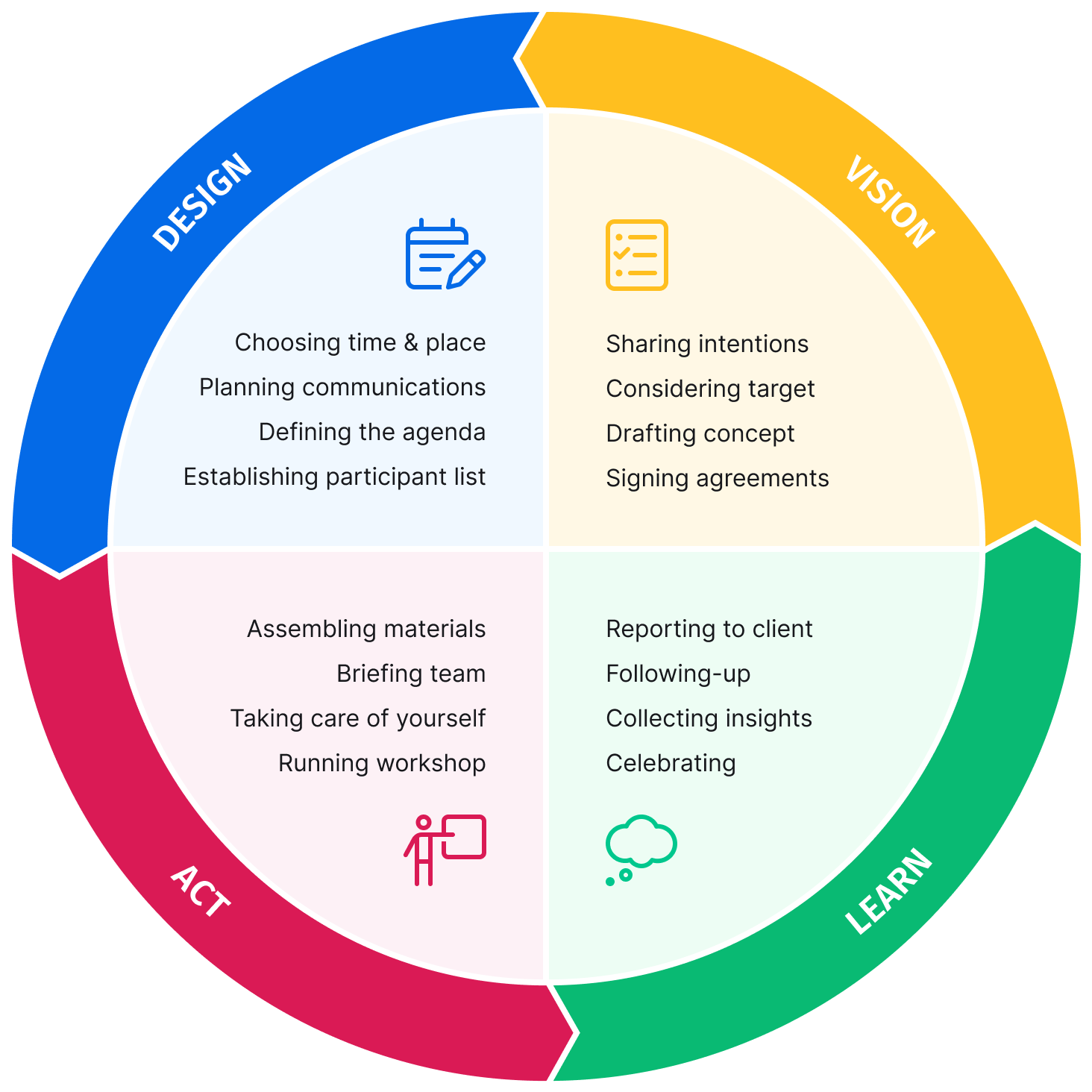
Now that it’s done, I realize it’s really not a circle at all, because once all the work is complete nobody, neither client nor facilitator nor participants, is in the same place they began from. The process of designing a workshop is actually like a spiral, that widens and opens each time we go around.
By the end of all these steps, everyone will have changed in some way. Relationships will have formed, new ideas defined, and lessons learned.
At the start of the spiral, there is only an idea, which becomes a design as it is shared, consolidated and refined. The facilitator’s job is to turn it into an agenda, and go through all these steps, alone or with a team, to make it happen.
By learning from all that took place, the flow will, in time, become more natural, fluid, almost second nature. My hope in setting it down in this piece is that it will help you along the journey.
Want to see an entire workshop journey in action and get help in putting together a water-tight agenda? Explore our workshop planning template to go through a proven agenda design process that will help you dazzle potential attendees.
Does this process describe how you have been designing your workshops? Did it give you new ideas? Leave a note in the comments, and join the discussion in our Community!
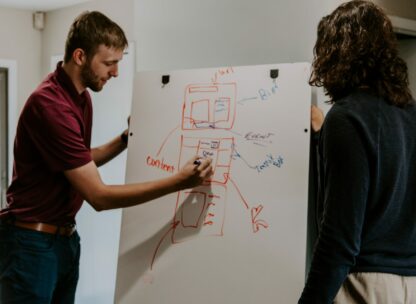

Leave a Comment